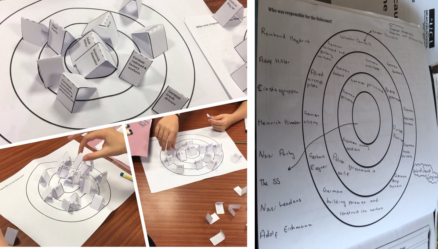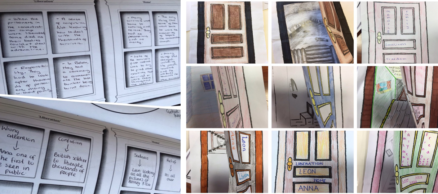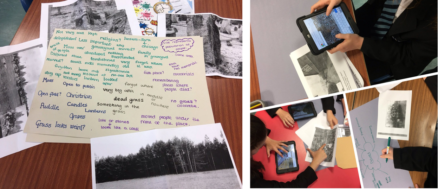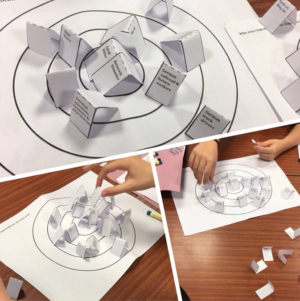Midway through our Holocaust scheme of work and our lesson nine asked the students to consider ‘Who was responsible for the Holocaust?’ My aim was for students to develop their understanding of perpetrators, collaborators, bystanders, rescuers and resistors. By using the Centre’s ‘Being Human?’ lesson materials and approach, students were able to analyse and discuss a range of sources to show an understanding of responsibility in the Holocaust, enhance their SMSC awareness and cultivate their emotional and historical literacy. Students would demonstrate their learning by completing the target diagram with examples of groups ‘responsible for the Holocaust’, thereby developing their understanding and awareness of cause and consequence.
 I was really pleased with the level of maturity that students showed with the target task. They were able to link lots of prior examples from previous lessons (Walter Rauff/truck drivers/Ukrainian soldiers) and apply it to the context here. The terms perpetrator, collaborator, bystander had just been studied in RS and Ethics, so it was sequenced well, and we drew upon prior learning in a cross-curricular fashion.
I was really pleased with the level of maturity that students showed with the target task. They were able to link lots of prior examples from previous lessons (Walter Rauff/truck drivers/Ukrainian soldiers) and apply it to the context here. The terms perpetrator, collaborator, bystander had just been studied in RS and Ethics, so it was sequenced well, and we drew upon prior learning in a cross-curricular fashion.
For lesson ten I wanted to explore What did it mean to be ‘liberated’? What did the survivors find at ‘home’? and in doing so for students to revisit Leon Greenman’s story. Lesson outcomes would see students contribute to a ‘Liberation’ and ‘Home’ brainstorm which supported interpretation and representation skills, complete creative and reflective ‘Windows’ on liberation and ‘Doors’ of home that was based upon source analysis and apply their literacy skills to a ‘Tenth Man’ analysis sheet. To do so, students would have to develop their understanding of what ‘Liberation’ and ‘Home’ meant in the context of the Holocaust and analyse oral histories to determine what they reveal.
Going back to Leon Greenman and his story here was well-timed. Students needed to link with this recurring leitmotif. For both videos of both Anna Bergman and Leon Greenman, students were totally engaged. To extend the windows activity, I also devised a ‘door’ for a cover lesson – ‘What was behind the door for Leon/Anna when they returned ‘home’?’ – this is something that I will definitely use again next year, as it allowed students to articulate the feeling of ‘nothing, nobody’ in a creative way and draw upon emotional literacy, the historical imagination and SMSC. They were also able to show the memories which the survivors may have had and juxtaposed this with what actually was at home in some cases.
 This powerful learning was continued in lesson eleven, when I asked students ‘What are the enduring consequences of the Holocaust?’ Building upon my study visit to Poland, thanks to UCL, I really wanted students to develop an understanding of remembering something that is no longer present and to have an opportunity to analyse a range of sources to uncover The ‘void’.
This powerful learning was continued in lesson eleven, when I asked students ‘What are the enduring consequences of the Holocaust?’ Building upon my study visit to Poland, thanks to UCL, I really wanted students to develop an understanding of remembering something that is no longer present and to have an opportunity to analyse a range of sources to uncover The ‘void’.
For this lesson, I completely redesigned what I had intended. I had just come back from the Warsaw Study Trip and so went back to my original scheme draft to see what could be added/amended. I am really pleased that I did this. From my trip, I understood ‘the void’ in such a way that I thought I would be able to get my students to understand it. The same concept was applied, with images, but this time with Jadow as the focus. I introduced iPads and Google Earth so that students could ‘walk around Jadow’ – they had images of places that I wanted them to find, with the maps. This was ‘clunky’ the first time I did it, so with some groups allowed them to ‘walk around Jadow’ so they were familiar with the area and then gave them maps, to point out certain areas. Once I scaffolded the activity further, this was more successful. I want to add more about the Shtetl next year, with examples of pre-war Jewish life in Jadow. Time allowed for the pre-war Jewish community in terms of photos, but I want to develop this so it shows more examples of the geography of the place pre-war i.e. images of typical Shtetl.
 The activity which linked to this was so well-received and memorable. A lot of curiosity through source investigation again – this time with images taken at the RC & Jewish cemeteries in Jadow and then Treblinka. The maps shown at the end of the lesson (UCL Void .ppt) then caused audible gasps, from every class. They had seen ‘void’ and were able to better understand what this was and therefore, that which was lost during the Holocaust. This learning was truly meaningful, impactful and developed both historical skill and the affective learning dimension. I need to firm up this lesson plan for next year’s scheme. Students were at the end able to contribute to Rymanow synagogue order sheet, which supported change and continuity work, and participate in Photo/Art analysis through Big Question sheets which further developed source analysis.
The activity which linked to this was so well-received and memorable. A lot of curiosity through source investigation again – this time with images taken at the RC & Jewish cemeteries in Jadow and then Treblinka. The maps shown at the end of the lesson (UCL Void .ppt) then caused audible gasps, from every class. They had seen ‘void’ and were able to better understand what this was and therefore, that which was lost during the Holocaust. This learning was truly meaningful, impactful and developed both historical skill and the affective learning dimension. I need to firm up this lesson plan for next year’s scheme. Students were at the end able to contribute to Rymanow synagogue order sheet, which supported change and continuity work, and participate in Photo/Art analysis through Big Question sheets which further developed source analysis.
On to lesson 12 and I wanted students to reflect upon ‘How can the memory of the survivors live on?’ Students would be encouraged to analyse and discuss a range of sources to unpack the term ‘legacy’. The success of the lesson would be judged on students contributing a poem title and their creative and historically informed responses to the lessons key question.
Yet again, student’s engagement was excellent, particularly with the video. The Note from Leon and the reveal of the wedding rings was particularly significant for most students. This imagery featured quite a lot in student work from the following task; ‘what is Leon’s legacy?’.
 Due to a task in the UCL Masters programme, I extended this task, from the ‘poem title’ activity to further develop interpretation and representation skills. I used the image of Leon’s arm, which was really interesting – ‘if you could give this image a title, what would it be?’ – I will definitely be keeping this idea for next year. It gave students the opportunity to support their ideas with evidence and recap on elements of Leon’s narrative.
Due to a task in the UCL Masters programme, I extended this task, from the ‘poem title’ activity to further develop interpretation and representation skills. I used the image of Leon’s arm, which was really interesting – ‘if you could give this image a title, what would it be?’ – I will definitely be keeping this idea for next year. It gave students the opportunity to support their ideas with evidence and recap on elements of Leon’s narrative.
By Charlotte Lane
Find out how Torpoint Community College’s Holocaust scheme of work drew to a close by looking out for Part Four of Charlotte Lane’s blog series

